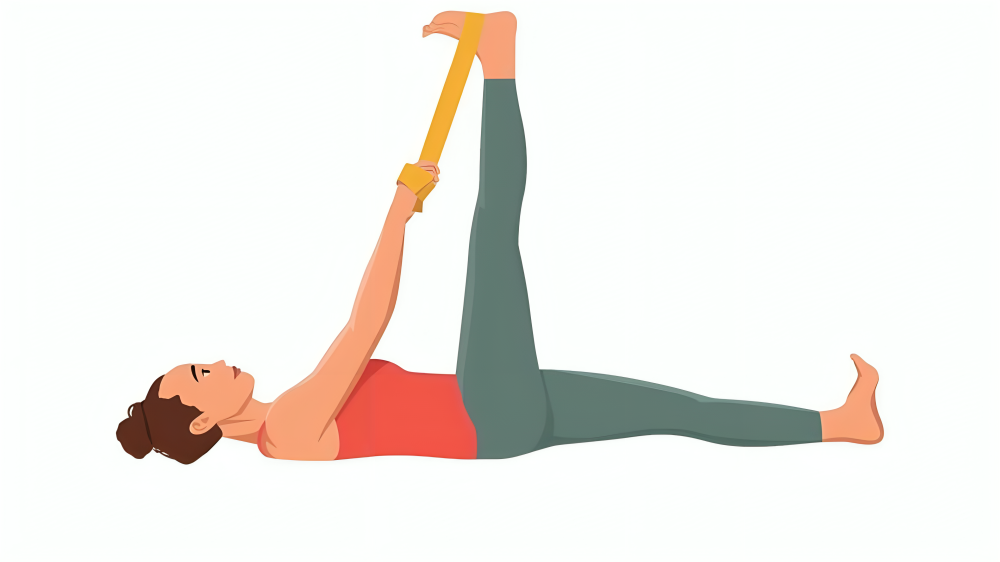
What is Supta Padangusthasana?
Supta Padangusthasana is a yoga pose where “Supta” means “reclining,” “Pada” means “foot,” “Angustha” refers to the “big toe,” and “Asana” means “pose.” So, it literally translates to “Reclining Hand-to-Big-Toe Pose.” This pose is primarily focused on stretching the legs, but it also engages your core, improves flexibility, and promotes relaxation.
How to Perform Supta Padangusthasana
Lie Down on Your Back:
Start by lying flat on your back with your legs extended and arms resting by your sides. Take a few deep breaths to relax your body.
Bend Your Right Knee:
Slowly bend your right knee and bring it toward your chest. Keep your left leg straight and grounded on the mat.
Grab Your Right Big Toe:
Use your right hand to grab your right big toe. If you can’t reach your toe comfortably, use a yoga strap or belt around the ball of your foot and hold onto that instead.
Extend Your Right Leg:
Gradually straighten your right leg towards the ceiling, keeping your grip on the big toe or strap. Ensure your shoulders are relaxed and your back is flat on the mat.
Hold the Pose:
Hold this position for 5-10 breaths. Focus on keeping your leg straight and your foot flexed. You should feel a stretch in your hamstrings and calves.
Switch Sides:
Gently release your right leg and repeat the same steps on the left side.
Relax:
Once you’ve completed the pose on both sides, lie flat on your back, close your eyes, and take a few deep breaths to absorb the benefits of the pose.
Benefits of Supta Padangusthasana
Improves Flexibility:
This pose is excellent for improving flexibility in the hamstrings, calves, and hips. Regular practice can help you achieve a greater range of motion in your legs.
Strengthens the Legs:
While stretching, you’re also engaging your leg muscles, which helps in building strength, especially in the thighs, calves, and ankles.
Enhances Core Stability:
Keeping your lower back on the mat and maintaining the pose engages your core muscles, leading to better stability and strength in the abdominal region.
Relieves Lower Back Pain:
Supta Padangusthasana can alleviate tension in the lower back by stretching the hamstrings and lengthening the spine, which often helps in relieving lower back pain.
Promotes Relaxation:
The gentle stretch combined with deep breathing helps calm the mind and body, making it a great pose to practice before bedtime or after a long day.
Improves Circulation:
By elevating your leg, you can help improve blood circulation, especially if you’ve been sitting or standing for long periods.
Supports Better Digestion:
The mild stretch in your abdomen and focus on breath can stimulate digestive organs, aiding in better digestion.
It’s here Upavistha Konasana how to do it and what are the Benefits
FAQs
1. What should I do if I can’t reach my big toe in Supta Padangusthasana?
If you can’t reach your big toe comfortably, don’t worry! You can use a yoga strap, belt, or even a towel around the ball of your foot. This will help you maintain proper alignment while still getting a good stretch.
2. How long should I hold Supta Padangusthasana?
Hold the pose for 5-10 breaths on each side. However, if you’re comfortable, you can stay in the pose for up to a minute on each side to deepen the stretch.
3. Can beginners practice Supta Padangusthasana?
Yes, Supta Padangusthasana is beginner-friendly. Just be mindful of your body’s limits and use props like a strap if needed. It’s important to avoid overstretching.
4. What if I feel discomfort in my lower back during the pose?
If you feel discomfort in your lower back, make sure your lower back is grounded on the mat. You can also bend the knee of the leg that’s on the mat for additional support. If discomfort persists, consult with a yoga instructor or consider skipping the pose until you’re more flexible.

